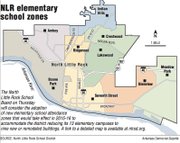Plan drawn, panel to weigh new NLR elementary zones
Wednesday, June 18, 2014
Proposed elementary school attendance zones to match up with the North Little Rock School District's new or extensively remodeled elementary schools will go to the School Board on Thursday for possible approval.
If adopted, the reconfigured school boundary lines for nine campuses would go into effect just over a year from now, in the 2015-16 school year.
"It's on the action agenda. They will debate it; they will discuss it. I think something will happen," North Little Rock Superintendent Kelly Rodgers said Tuesday about the likelihood of a board decision.
Board action on the proposed zones would be the culmination of months of work by demographic consultants based in the Kansas City, Mo., area and a citizens committee assigned the job of reshaping the attendance zones to conform with the change from 13 elementary school campuses down to nine.
The North Little Rock School District is in the midst of a $265.5 million capital improvement program in which the district's 21 elementary and secondary campuses will be reduced to 13, almost all of which will be built anew or significantly remodeled.
Only the elementary schools will have attendance zones. All students will attend the same middle school, and all students will attend the same high school once the construction work is completed.
Rob Schwartz and Matt Wendt of RSP & Associates demographers and members of the Elementary Boundary Committee will present the zone maps to the board, Rodgers said.
"We are trying to get the word out to parents," he added. "We put it on our website. We put it on the North Little Rock School District Facebook page. We are going to do the robocalls to parents to remind them. I've called several groups around town that have been interested.
"They may or may not come out to the meeting," he said. "But we want to be transparent -- let them come out and listen and be involved."
The board set parameters for the new boundaries earlier this year. The area in each new attendance zone was to be contiguous, meaning that each school would serve its surrounding area, not any distant satellite area or a pocket of students located in another part of the city.
Rodgers said the new plan also attempts to minimize the number of pupils who would have to cross major thoroughfares or railroad tracks to get to their schools. In cases in which crossing streets and tracks is necessary, district leaders plan to provide bus transportation for pupils -- even if they live within the 1.5 mile "walk zone" of their school, Rodgers said.
Also to be considered by the planners were a racial and socioeconomic mix of pupils for each school, and the student population in the area so that the school would not be over- or underenrolled.
Six of the nine elementary schools will have a capacity of 473 pupils when the construction is finished. Those are Amboy, Boone Park, Crestwood, Lakewood, Meadow Park and Seventh Street elementaries. Glenview Elementary's capacity will be 322. The capacity at Indian Hills and Ridgeroad will be 624. Ridgeroad is now a middle school but will be converted to an elementary campus.
Rodgers said a few of the schools may be over capacity in the early years of the plan because of a proposal to allow current pupils in the schools to be "grandfathered" into their schools until they complete all grades, even though they would be zoned for a different school under the proposed zone plan.
Indian Hills and Lakewood would be the schools directly affected by that, meaning their enrollments would slightly exceed the schools' capacity.
The anticipated racial makeup of the elementary schools is projected to range from 16.2 percent black at Crestwood to 87.6 percent black at Meadow Park. The white enrollment is expected to range from 6.8 percent at Seventh Street to 75 percent at Crestwood. The Hispanic enrollment is projected to range from 2.7 percent at Meadow Park to 22.5 percent at Ridgeroad.
Stephen W. Jones, an attorney for the school district, addressed in a letter to Rodgers the question of whether the district must comply with any particular racial-composition guidelines. The North Little Rock district was released from federal court supervision of its school desegregation efforts in 2012.
"It must be remembered that no particular level of racial balance is required in any school, even in the case of a still desegregating school district operating under court supervision," Jones said in the letter.
"More important, however, NLRSD is no longer such a desegregating district operating under court supervision," he said. "Rather, it is now a constitutionally compliant, unitary school district, which significantly changes the standard for reviewing its actions. When a district is unitary, the standard for court intervention is whether the district acted with the intent to cause segregation."
Jones concluded that he sees no legal problems with the proposed attendance zones.
"Certainly, there is nothing to suggest any intent to promote racial segregation. In fact, the ultimate results are a more integrated student population rather than a more segregated one, with every zone having facilities of equal quality," he said.
Metro on 06/18/2014
